History about Digital computation :
The classical computers that we use today are digital electronics devices. But in the early days, this was not the case, in fact the first computer designed as a analog computer. It was bulky in size, it took entire space inside a room but it performed only very simple calculation. These analog computers took more power to operate and it is not reliable. To cut the long story short, analog computers are not easy to maintain and operate. For these reasons, we had started to use digital computers. First, how we developed digital computers?
It was possible after the invention of an electronic device called transistor. Transistor paved the path for digital computation era.
What is a digital data?
To understand this, first we need to understand about analog data. Let’s understand about the analog data with the simple example.
let’s say you are measuring the temperature in your city in a day.
Analog quantity
- If you are measuring the temperature at every instant of time from 6 A.M to 6 P.M (however you can set the time interval of your choice, here in this example I set the time interval to be 6 A.M to 6 P.M ). Here the main point to note down is measuring the temperature continuously from start time to end time. Now if you plot a graph from the readings you observed from the test, then this data be analog in nature. Plot the time in X-axis and value of temperature in Y-axis.
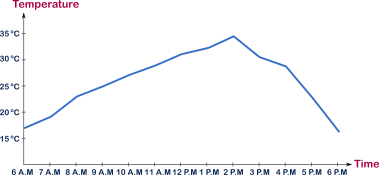
Discrete quantity
- If you are measuring the temperature at distinct intervals of time from 6 A.M to 6 P.M (let’s say you are measuring at every hour). Now if you plot a graph from the readings you observed from the test, then this data be discrete in nature.
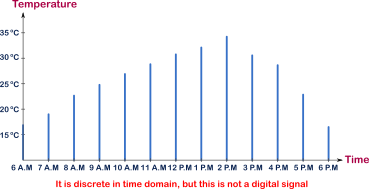
Digital quantity
- Then how to get digital data from this, simple if we measure the temperature at distinct intervals of time with distinct value of temperature then we can get the digital data. Now if you plot a graph from the readings you observed from the distinct temperature value test, then the data will be digital in nature. Plot the distinct time intervals in X-axis and the distinct value of temperature in Y-axis. The important point to note over here is the temperature and the time both are discrete quantities here.
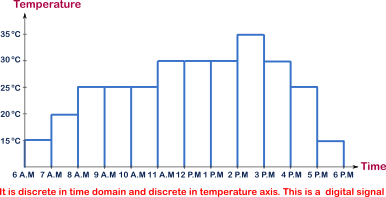
In the above temperature graph example, the digital version of the temperature data doesn’t correctly represent its analog data. To accurately represent the digital version of an analog data, we need to increase the number of quantization levels. ( I will explain about quantization in the upcoming post) Here in this example, I considering a five level of quantization (i.e., temperature between 15 – 35 degree Celsius is taken as five levels of quantization with constant step size of 5 degree Celsius). Here, bottom of each quantization level is taken as quantization value.
Do you know why we need digital electronics in the first place?
We live in a analog world. What do I mean by that? Let’s take an example, what is the time now? It may be some HH:MM:SS. But for the common man, we only need time representation limited to hours and minutes. Most of the cases, we as a common human being never think about the seconds. But, in reality the time may be splits as hour, minute, seconds, milliseconds, microseconds,.. and goes on. Mostly, as a common ordinary human being we represent time in hours and minutes only. The very nature of time itself is a analog quantity in our real world. But, for our convenience and ease of expression, we manipulate it as a digital quantity.
Real world interpretation of analog quantity
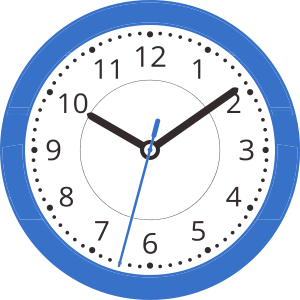
An analog clock
Here an analog clock is shown, in which time is calculated as an analog quantity. Well, how is it you ask? in analog clocks each and every instantaneous part of time is measured but it only displays the hours, minutes and the seconds part. Now you may have a doubt, in this analog clock also it doesn’t shows all the instantaneous part of time, then how you call it as an analog clock? Here in analog clocks, each and every instantaneous part of time is calculated, but the thing is only the necessarily required part of the time i.e., hours, minutes and seconds part is displayed. This doesn’t mean that it is not measuring the all instantaneous part of time.
Ex. in analog clocks, all the instances of time between the interval 1 second and 2 seconds is measured,( i.e. 1.5 seconds, 1.59 seconds, 1.75 seconds etc.,) but it is not displayed effectively. This is why it is called as analog clock, in our case an analog quantity.
Real world interpretation of digital quantity
With the help of digital quantity we can easily manipulate a complex analog quantity. For example, lets take the time, it is a analog quantity by nature. But for common man, it is enough to represent it as a digital quantity with hours, minutes and seconds representation. Just imagine, if we want to display time as each microsecond, nanosecond…., then what will be the size of our wrist watches?
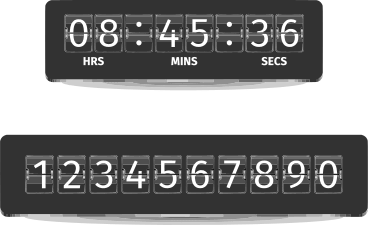
digital clock
Here, a digital clock is shown. Do you know why it is called as digital clock? The instantaneous part of time between the 1 second and 2 seconds is neither measured nor displayed in the digital clocks. What do I mean, here after the 1 second the next instant of time measured and displayed will be 2 seconds. It neither measured nor displayed the 1.1 seconds ,1.12 seconds,…..1.25 seconds, 1.26 seconds,…..1.9 seconds etc.,. It only measures every second interval of time. This is why it named as digital clock, in our case digital quantity.
We have some basic logics to correctly represent the analog quantity as digital quantity with minimum possible error. These all fundamental logics form a branch of electronics that we will call as a Digital Electronics.
Advantages of digital computation :
- Storage of digital data are easy and cheap when compared to analog data.
- Transferring of digital data is easy and efficient, when compared to transferring of analog data.
- Digital data (or) information is immune to noise when compared it to analog information.
- Don’t need a complex hardware setup for computation of digital data.
How to convert an analog signal/data into a digital data :
First sample the analog data with the required discrete interval of time as samples. After the sampling we get the analog data as a discrete time data, with the sampling time/interval as discrete time. Now you may have doubt about what is meant by sampling? I will explain about it in a great detail in the future post. For now, just understand it as a simple on/off switch operation in the time axis with the constant on/off time interval known as sampling interval.
After the sampling, we get discrete time data, in order to change it as a digital data, we need to perform the quantization operation. Now you may have doubt about what is meant by quantization? I will explain about it in a great detail in the future post. For now, just understand it as a simple on/off switch operation in the temperature axis with constant on/off temperature interval known as quantization step.
Quantization Error :
The difference between the actual value to the quantized value is known as quantization error. We need to maintain this quantization error is as minimum as possible while we performing analog to digital conversion.
The first thing to note, whenever we convert an analog data to digital data, first we need to represent the same analog data as a digital data without any error. But in this example, there is an error at 1 P.M, because at 1 P.M temperature is around 32oC , but in our digital representation it is quantized to 30oC, how we can overcome from it? that’s simple, if we increase the number of quantization level then we can reduce the error. If number of quantization level is very large, then potentially we can eliminate the quantization error.
Conclusion :
We mostly interact with the analog data in the nature. Most of the data surrounds us is analog in nature. But due to it’s complex nature, we mostly use the digital data in the computation purposes. For that, first we need to convert the analog data we have into digital data, and perform the required calculations with the help from digital computers using this digital data. Once the computation completed, we again change the data to its analog form, because human beings understand the analog data with ease. Both analog data and digital data both are required, depends upon their need we can use these accordingly.



2 Responses
Sharing is caring the say, and you’ve done a fantastic job in sharing your knowledge on your blog.
Your site visitors, especially me appreciate the time and effort you have spent to put this information together.